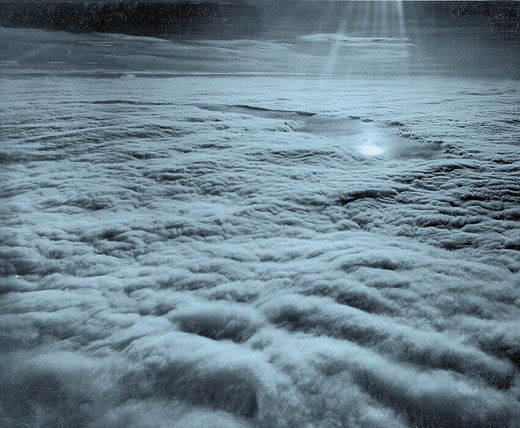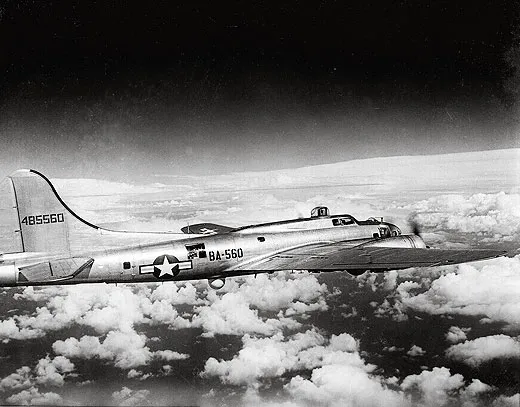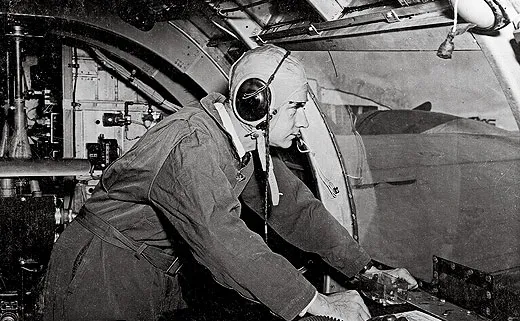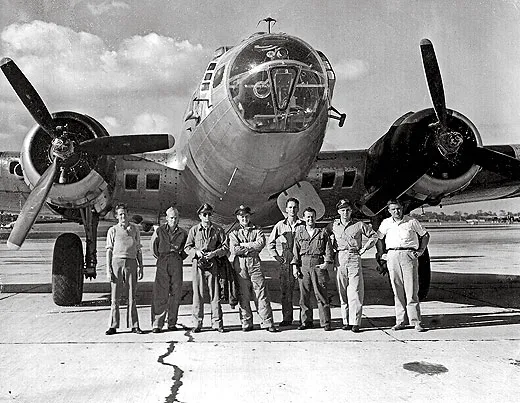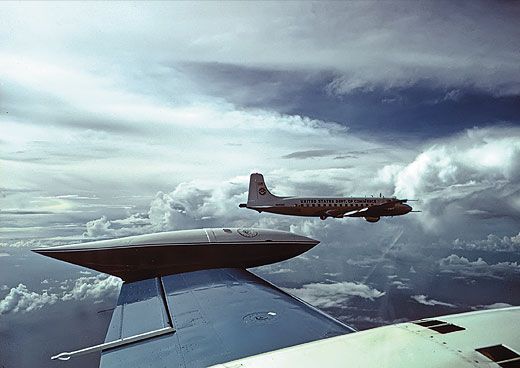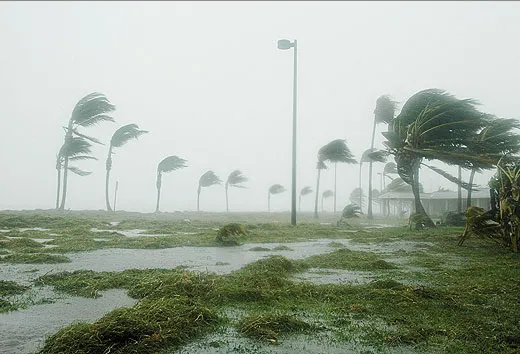Climate Control
Irving Langmuir tried to change the world one storm at a time.
/https://tf-cmsv2-smithsonianmag-media.s3.amazonaws.com/filer/climate_control_flash.jpg)
Three years after the brutal 2005 season that brought Katrina and other storms, the U.S. Department of Homeland Security began studying how to quell hurricanes. Some of the ideas it looked at, like seeding hurricanes, are conventional. Some, like dyeing hurricanes with soot, are a little out there. Since the middle of the last century, the government has spent millions of dollars on weather modification—and the only thing the scientists really had to show for it was some wild stories. Indeed, Homeland Security would be wise to revisit the efforts of a Nobel Prize winner who once sought to tame the weather.
On the morning of October 13, 1947, a Boeing B-17 loaded with 180 pounds of crushed dry ice took off from MacDill Field in Tampa, Florida. Two days earlier a hurricane had wreaked havoc in Miami, but had since been treading water 350 miles off Jacksonville, where it seemed ready to wind down. The U.S. Air Force B-17 rendezvoused with the storm and climbed 500 feet above its dark upper clouds, where the crew sprinkled it with a few thousand white peas of dry ice (frozen carbon dioxide). The airplane circled for a while, then turned for home. For reasons as obscure as they were controversial, the hurricane followed.
The storm, which had been drifting to the northeast, executed a full pivot, as if tracing a “7” from the bottom up. Gathering momentum, it barreled toward the Atlantic coast and slammed ashore near Savannah, Georgia, where it chewed up terrain for miles inland, causing $23 million in damage ($220 million today) and killing a few people. Pretty soon, reports about the B-17’s actions began circulating in southern newspapers. The military denied that the experiment had diverted the storm, but commanders refused to release flight details and scientific data. Furious locals threatened lawsuits, and denounced the shadowy mission as a “low Yankee trick.”
Meanwhile, safe in his lab in upstate New York, the Yankee in question, Irving Langmuir, analyzed the storm data with grim satisfaction, sympathizing with Savannah but confident he’d proved that humans could, at last, control the weather.
Until that October day, Langmuir could only call himself one of the great chemists of the 20th century. He had won the 1932 Nobel Prize in chemistry, and his contributions to the General Electric research lab—a better incandescent lightbulb among them—helped the company become one of the richest in U.S. history.
But Langmuir aspired to more than better light bulbs. He came to weather modification in his 60s, but suddenly saw a chance to end the capricious rule of weather over our food supply and to rob nature of its ruinous power. In a 1948 Fortune magazine article, he boasted, “There is a reasonable probability that in one or two years man will be able to abolish most damage effects from hurricanes.” Previous projects to alter the weather had been dominated by kooks and pseudo-science, but Langmuir had clout and charisma, and he persuaded GE, the U.S. Army Signal Corps, and the Office of Naval Research to collaborate on Project Cirrus just after World War II. The hurricane that turned on Savannah was Cirrus’ first big test.
The project began inside a $240 GE home freezer. In 1946 Langmuir and a GE machinist, Vincent Schaefer, rigged an open-top freezer to mimic the cold upper atmosphere, in which they hoped to create precipitation. They lined the freezer with black velvet to make any precipitation easier to see. Icicles thick as carrots lined the top rim. To form “snow,” Schaefer exhaled a breath (which is largely water vapor) into the chamber.
At first, Schaefer and Langmuir struggled to create realistic precipitation. Water normally freezes at 32 degrees Fahrenheit, but it can also persist in a stubborn supercooled vapor state, invisibly suspended in the air, at below-zero temperatures. Progress was stalled until a roasting July day. The heat prevented the freezer from cooling properly; to lower the temperature Schaefer went to a nearby lab and borrowed a block of carbon dioxide, which freezes at –109.3 degrees. When he lowered it into the chamber, he watched with amazement as a bluish fog appeared. The temperature had finally dropped enough to drag the vapor out of suspension. When Schaefer huffed this time, ice formed instantly, thousands of tiny droplets that glistened on the black velvet like diamonds on a jeweler’s cloth. Clouds in the sky are also suspended water molecules, and the molecules fall as precipitation only if the water coalesces into heavy drops or ice. The freezer experiment seemed to illustrate an easy way to accelerate the process.
Not long after, a second breakthrough took place. Dry ice has limitations: It has to be dispensed in small, careful doses, lest it “choke” clouds of vapor and prevent ice from forming. So another assistant, Bernard Vonnegut (older brother of writer Kurt), created ice with silver iodide. Silver iodide crystals have the same hexagonal structure as ice and can trick water molecules into latching on. Though purified silver iodide was more effective than crushed dry ice for generating precipitation, it was harder to make.
After these breakthroughs, Langmuir’s colleagues threw themselves into more experiments. Duncan Blanchard, a GE assistant scientist in the late 1940s, remembers each personality distinctly. Langmuir, ever dapper in his suits, was the driving force, he says. The mechanical genius was Schaefer, a high school dropout. Schaefer, among others, jokingly referred to Langmuir as “Boss” behind his back —“Where’s Boss? Boss in today?”—but always as “Doctor” to his face.
Inside the lab, things were less formal. Blanchard remembers Vonnegut’s dingy workspace “in complete disarray, with bits and pieces of wire, old test tubes, rubber tubing, and parts of generators covering most of the bench space and dripping off onto the floor.” But all three men had one trait in common. “Langmuir, Schaefer, Vonnegut were always enthusiastic even when the project did not seem to work out,” says Blanchard. “Science there was glorious entertainment.”
The enthusiasm seemed warranted after the first aerial cloud seeding, in November 1946. GE rented a Fairchild 24 airplane, and during the flight, Schaefer identified a four-mile-long altostratus cloud at 14,000 feet. While passing over it, Schaefer slowly dispensed three pounds of crushed dry ice through a funnel. According to eyewitnesses, the cloud “writhe[d] in torment,” and within minutes had transformed into snow. That the snow fell just 2,000 feet before evaporating didn’t prick the team’s enthusiasm. Langmuir, observing from the ground, watched the cloud quake and shouted, “This is history!”
A more ambitious experiment followed in December, near GE headquarters in Schenectady, New York. Schaefer seeded clouds with a bigger load of dry ice, but this time the clouds kept drifting, seemingly unperturbed. A day later, upper New York and Vermont were hit with the biggest snowstorm of the season. Scores of car accidents followed, and businesses shut down for a week. New Yorkers were peeved.
So far, the experiments seemed solid, but many meteorologists doubted the team’s conclusions. Francis Reichelderfer, head of the U.S. Weather Bureau, told Time, “I feel quite sure that in many cases [Langmuir’s] rain was due to natural causes.” The bureau argued that weather systems are immensely complicated, and just because a cloud seeded one day started snowing the next doesn’t mean that seeding caused it. Also, said Reichelderfer, Langmuir’s men didn’t seed clouds randomly, but picked “ripe” clouds that probably would have snowed (or rained) anyway.
Clearly, more experiments were needed, but after the snowstorm in Vermont and New York, GE lawyers had a conniption: GE faced staggering legal liability. They insisted Langmuir secure the cooperation of the U.S. military, which was shielded from legal threats.
As much as his scientific acumen, it was Langmuir’s stature and eloquence that saved Project Cirrus. “He could convince you that black was white—he had an acting voice,” says Blanchard. “He had the ability to charm.” Blanchard still remembers the day the Army Signal Corps dispatched a junior officer to GE to interrogate Langmuir about weather modification: “The [officer’s] instructions were ‘Milk him dry. Milk him dry.’ We heard about that in the lab and we just laughed,” says Blanchard. “A day or so later, Bernie [Vonnegut] and a friend saw this chap at lunch with Langmuir. Langmuir was carrying on an animated conversation while this person sat there with a glazed look on his face. Langmuir’s cow was far from being milked dry!”
Military cooperation gave Langmuir access to airplanes more powerful than the cropdusters GE had rented. Typically, a B-17 with a five-man crew would dump 80 pounds of dry ice each run; support aircraft followed to take readings and pictures. The crew targeted wide sheets of clouds, and used the dry ice to etch figures into them: Ls, Greek gammas (γ), and racetracks 20 miles in diameter. They were experimenting; they didn’t know what the optimal pattern would be.
The Savannah hurricane spooked the GE legal department all over again, so Langmuir headed out to arid New Mexico and began seeding clouds with silver iodide smoke. The work lasted around two years, and in announcing the results, Langmuir threw out all his normal scientific prudence. Just cents’ worth of silver iodide, he claimed, initiated dozens of rainstorms. One reportedly stretched 4,000 square miles and liberated 200 billion gallons of rainwater. “[It] could not possibly have been accounted for as the results of naturally occurring rain,” Langmuir insisted.
The scientist appeared on the cover of Time, hailed as a literal rainmaker, and he even quit his job at GE to barnstorm the country—“Langmuir Quits Post to Pursue Rainmaking,” read the New York Times headline. A mesmerizing speaker, he wowed early-1950s audiences.
Sensing a quick buck, private pilots retrofit their airplanes with seeding equipment and began treating clouds in six states. But for every rancher or city water engineer eager to seed, a farmer or hotel owner raged about hail and poor sightseeing. In 1952, a U.S. senator from Michigan, Blair Moody, promised to open a Congressional inquiry because the spate of rainy weekends that Langmuir claimed to have caused was, a local newspaper wrote, “spoiling Michigan’s lucrative tourist business and ruining lots of picnics.”
If Project Cirrus was controversial among citizens, it was notorious among some meteorologists, who dismissed Langmuir’s claims as voodoo. In examining the 200-billion-gallon storm in New Mexico, Weather Bureau scientists concluded that the prior day a common warm front had swept in from the Gulf of Mexico, and it, not Langmuir, had created the rainfall. They also noted that no one had sued GE over the Savannah hurricane because in 1906 a hurricane had followed an identical path, taking the same mid-ocean turn and causing just as much damage on shore. Weather Bureau scientists hooted loudest of all when Langmuir argued that his airplanes were altering weather patterns as far away as Scotland.
With the Weather Bureau and Langmuir in disagreement, in 1952 Project Cirrus ended in a stalemate. GE was all too glad to extricate itself, and in 1957, Langmuir died, of complications from multiple heart attacks. But even with the chief proponent of weather modification gone, the cause attracted ambitious converts. A few horrendous storm seasons in the mid-1950s gave them a chance to test their theories. Washington (after a bureaucratic delay) decided to launch Project Stormfury in 1962, through the Navy and the Department of Commerce. This was no casual mission. Its goal was to hunt—and kill—hurricanes, by sending pilots deep inside the storms to do battle.
Few storms rattle an airplane like a hurricane. “There were some times when the turbulence got so bad that I thought, Damn, I maybe misjudged this one,” recalls David Turner, a former Stormfury pilot who flew DC-6s and WC-121s. “Except you’d hit a point where backing off was worse than going on.” So he usually plowed ahead.
“The turbulence is a rolling, boiling kind,” says Turner. “And we could see zippo,” just gray streaks of clouds and rain. The lack of vision intensified the sounds: “There was a roaring hammering of the rain on the airframe, a wild roar.”
And then the eye. Not all hurricane missions penetrated the eye, but pilots sure remember when they did. Some described a “Tarzan moment”: staggering forward out of a dark cave of clouds, fighting through sheets of water like a waterfall, wet and angry—then emerging into crisp brilliant air. “You can see all the way up forever, to the stars and the moon,” says Turner. “The wind drops off to zero. Sometimes it would have been such a painful transit getting in there, I’d fly a few times around in the clear, and we’d have a cup of coffee and go to the bathroom and straighten up the airplane.” Eventually, they girded themselves and plunged back into the cloud bank.
In 1969, Turner started flying for the Florida-based Stormfury, doing seeding runs and ferrying dozens of strapped-down scientists into storm cores to gather data. Stormfury’s yearly budget, $2 million, outpaced Cirrus’ ($750,000 at its peak), and that didn’t include the millions spent outfitting airplanes, including Lockheed P-3 Orions, for hurricane hunting. Instead of dumping seeds through funnels, as had been done in Cirrus, some Stormfury scientists developed 130-pound bombs with fins. Others went micro, developing plastic flares a few inches wide, called “candles,” that worked on a delayed fuse and streamed silver iodide for 36 seconds as they fell.
Despite fires, turbulence, and other dangers—or perhaps because of them—Stormfury scientists had a cowboy cockiness about playing with hurricanes. They chafed at government restrictions, which limited company pilots to seeding only hurricanes that had no chance of striking land. “Bureaucrats are scaredy-cats,” one anonymous Stormfury scientist growled to Time.
The scientists were cocky because, they believed, they had finally developed a fail-proof way to defuse hurricanes. Hurricanes can stretch for hundreds of miles, but they concentrate their fury in the eyewall, the bank of swirling clouds orbiting the eye, which in powerful storms span only a few tens of miles. The tighter the eyewall, the greater the concentration of energy, and the greater the damage when storms hit land. Stormfury scientists calculated that if they sprinkled silver iodide in a wide ring around the eye, the seeded clouds would writhe, rain, and collapse. This would disrupt the eyewall, sucking it outward by 10 or so miles, and crank down the winds that cause destruction.
Because of the scales involved, each seeding run required 10 or so airplanes to fly laps for an hour or two in the murky dark, in a counterclockwise swirl that required remarkable coordination. Hugh Willoughby, a former Stormfury scientist, says his colleagues knew exactly how many airplanes to fly and how far apart to fly them. They knew what chemicals to dispense, how much, and when. They knew the type of signals they wanted to see on satellites and on radar. And see them they did: Early experiments clearly showed eyewalls getting wider and wind speeds falling.
But as the science got more objective and rigorous, support for seeding hurricanes unraveled. Blind experiments with non-storm clouds—where pilots would randomly tear open one of two sealed envelopes, which contained instructions to seed or only pretend to—proved that scientists on the ground could not reliably predict, based on observations alone, if clouds had been seeded. Some seeded clouds did nothing, and some unseeded ones blew up like mushroom clouds.
In light of these experiments, Stormfury faced the same troubling questions: Did eyewalls sometimes widen spontaneously, without human intervention? Meteorologists could not find enough suitable storms near Florida to examine, and in the early 1970s their work ground to a halt. When the scientists tried to revive the project a few years later, political forces worked against them. They tried to shift hurricane seeding to the Pacific Ocean, but China, Japan, and Australia said loud and clear the United States better back off.
Stormfury’s coup de grace came in the early 1980s, when Hugh Willoughby and two other alumni wrote a demoralizing scientific analysis. They concluded that hurricanes did form new eyewalls all the time—with or without seeding. They also showed that the amount of supercooled water in hurricanes—a necessary ingredient for seeding—was orders of magnitude smaller than scientists had assumed. All in all, then, seeding had probably not disrupted a single hurricane, and any observed decreases in wind speed were probably coincidental. In 1983, the Department of Commerce killed Project Stormfury for good.
Weather modification combines two ancient dreams of humankind—flying and controlling the weather—and the hope of joining the two has never quite died. Private companies still seed clouds to bring rain, and China famously seeded Beijing skies to ensure clear weather before the 2008 Olympics. Colorado meteorologist Bill Woodley, a Stormfury veteran running the Homeland Security study, believes computer simulations will bring a new era of sophistication. “The explosive development of numerical models and computers allows us to play God, essentially,” he says, and evaluate scenarios without expensive tests. “In a year or two, we hope to weed out those hypotheses that have real merit.”
Willoughby, however, questions the ability to generate rain that falls all the way to the ground: “Many very smart people spent tubs of money seeding clouds, but I know of no published example of an experiment where one investigator applied a given technique to achieve a statistically significant increase in precipitation and another applied the same technique in a different setting to get the same result.” He adds, “Since replication is the essence of science, one is tempted to say that it was all nonsense.”
Though most scientists remain skeptical about controlling weather, Projects Cirrus and Stormfury still made important contributions to the field of meteorology. The thousands of seeding runs helped scientists piece together how storms behave, work that has produced better forecasts and thus saved innumerable lives: Despite an exploding U.S. coastal population, the likelihood of dying from a hurricane now is 1/100th the likelihood in 1900.
Still, Irving Langmuir would be crushed to see the lowly state of weather modification today. However sophisticated it has grown since 1946, meteorology remains a passive, not active, science. Pilot David Turner remembers his own pangs on Project Stormfury’s demise. “We’d spent a lot of time, and there were a lot of airplanes involved,” he says. “It was disappointing to finally concede we couldn’t really do it. The storms were so big, and we were so small.”
Sam Kean is the author of The Disappearing Spoon (Little, Brown, 2010).
